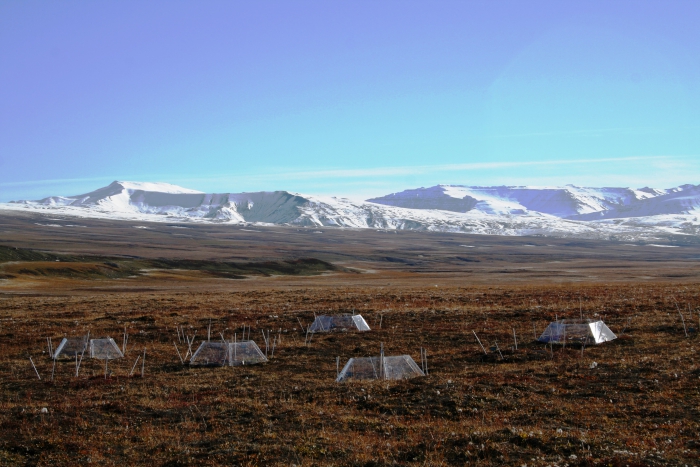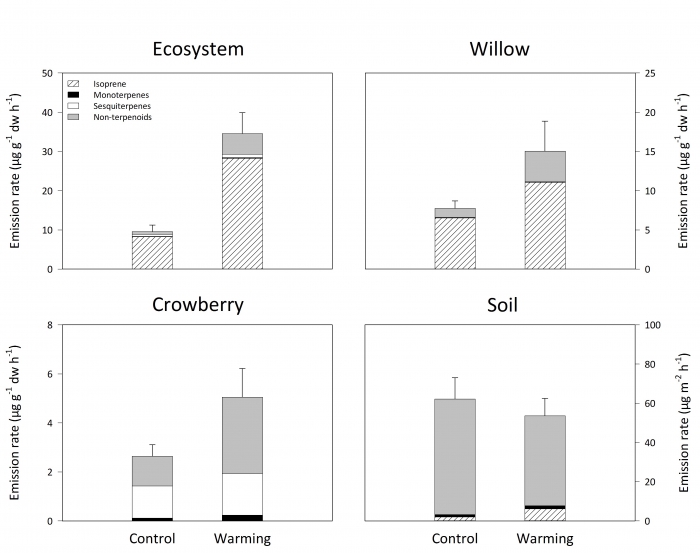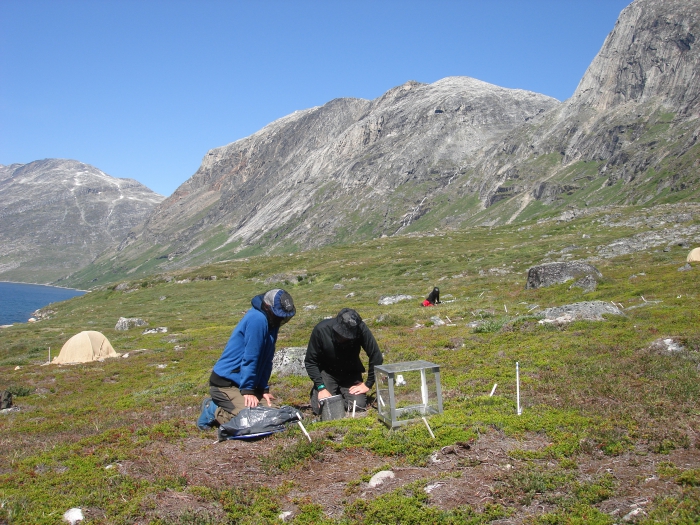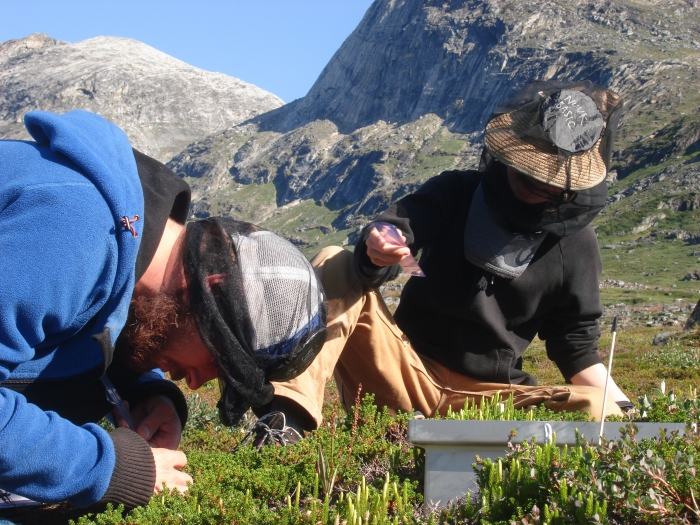By: Riikka Rinnan and Magnus Kramshøj, Department of Biology and Center for Permafrost, University of Copenhagen, Denmark
Volatile organic compounds (VOCs) are gaseous chemicals originating from a range of man-made sources like traffic and paint fumes, and natural sources such as plants that emit VOCs to deter pests, attract pollinators, or to protect their leaves from heat. In the atmosphere, VOCs rapidly undergo reactions influencing the concentrations of greenhouse gases like methane and ozone. Furthermore, atmospheric VOCs contribute to the formation of particles that scatter radiation and can even condense to form clouds, which may actually cool the climate.
A research team, including Riikka Rinnan and Magnus Kramshøj from the Center for Permafrost at the University of Copehagen, Denmark recently conducted studies to assess the VOC emission response of vegetation to warming temperatures in the Arctic. The team's results, discussed below, showed that warming caused a significant increase in emission rates for plants that is considerably higher than what is observed at more southern latitudes, emphasizing the high temperature sensitivity of ecosystem processes in the changing Arctic (M. Kramshøj 2016).
Until recently, the Arctic was considered an insignificant area for research into natural VOCs. It was thought to be too cold, have too few plants, and too short growing seasons. Not fully appreciated was how efficiently the dark soil and vegetation surface on the tundra heats up in the sunlight, that the tiny plants are extremely efficient during the short Arctic summers, and that the Arctic climate is experiencing drastic increases in temperature. The temperature is increasing twice as fast as the global average temperature. As a matter of fact, tundra heaths even in far north Greenland release measurable amounts of VOCs.
Knowing that the release of volatiles from plants is highly temperature-dependent, the team set out to study how the predicted climate warming will affect VOC emissions from the Arctic tundra. A field experiment was set up near Nuuk, Greenland to monitor changes in ecosystems caused by climate changes. Small open-top greenhouses were used around plots of vegetation to create areas a few degrees warmer than the surrounding plants. These plots, created to mimic future climate conditions, were compared to plots of vegetation without the extra warming (see Figure 1). Similar experiments have also been conducted on Disko Island and Zackenberg, Greenland and in Abisko, Swedish Lapland.

In Nuuk, the team measured consistently higher volatile emissions in the warmed plots, even though the vegetation cover in the open top greenhouses had decreased over years of warming. Despite fewer plants per ground area, the vegetation grown in the open top greenhouses released three to four times more VOCs than the plots without this warming (see Figure 2). To locate the origin of the effect, we measured separately on each of the dominant plants—an Arctic willow and an evergreen crowberry—while also surveying the effect on the bare soil. We could see that warming stimulated the release of volatiles from each of the two dominant plants and the whole ecosystem, while having no impacts on release from soil. This result points towards an extreme temperature sensitivity in Arctic plants. They might be tiny, but they are also adapted to make use of all the available warmth and sunlight during the short summer. It might also be that the response is a combination of the elevated temperature and drought. Lack of water may have stressed the warmed plants, and plant stress is known to increase VOC emissions.

The results across our experimental sites are surprisingly similar: warming by a few degrees causes several-fold higher emission of VOCs from the tundra. This is a drastic response compared to more southern areas. The typical expectation is for about one third more plant volatiles in response to this kind of rise in temperature. It is also a tremendous response compared to how much other biological processes change upon warming.
In the Greenlandic sites, the large increase in the release of volatiles has appeared without a vegetation expansion and seems like a direct plant physiological response. In Abisko, where water availability is not limiting plant growth, we have observed shifts in vegetation, with some species boosted and others declining under elevated temperature. In general, with climate change we are expecting more plant growth in the Arctic. And clearly, if the plant species cover changes, the volatile blends will also change as different plants produce different VOCs. If the vegetation grows denser, higher, or expands to new areas, more volatiles will be released as a result of more VOC producing leaf mass per ground area. The team concludes that an increasing load of volatiles from nature in the Arctic can therefore be expected.
Why is this relevant? VOCs are not greenhouse gases, but because of their high reactivity in the atmosphere they have many impacts in the air close to their source. Perhaps the most relevant are the impacts on tiny particles in the atmosphere known as aerosols. These aerosol particles can grow big enough to form clouds. What is exciting is that aerosols and clouds can actually cool the climate and thus mitigate the warming impact of greenhouse gases. There are still many uncertainties in the formation of aerosols and clouds from VOCs, but one thing is certain: If the Arctic continues to warm as expected, much more VOCs will be released from the vegetation in these areas. As the man-made sources of VOC pollution are rare in the Arctic, the plant volatiles are the most important player in this region.


More information about this project and field stations is available on the Cnter for Permafrost website.
Selected References
Kramshøj M., Vedel-Petersen I., Schollert M., Rinnan Å., Nymand J., Ro-Poulsen H., Rinnan R. (2016) Large increases in Arctic biogenic volatile emissions are a direct effect of warming. Nature Geoscience 9: 349–352.
Lindwall F., Schollert M., Michelsen A., Blok D., Rinnan R. (2016) Fourfold higher tundra volatile emissions due to arctic summer warming. Journal of Geophysical Research: Biogeosciences 121: 895-902, doi: 10.1002/2015JG003295.
Lindwall F., Svendsen S. S., Nielsen C. S., Michelsen A., Rinnan R. (2016) Warming increases isoprene emissions from an arctic fen. Science of the Total Environment 553: 297-304.
Rinnan R., Steinke M., McGenity T., Loreto F. (2014) Plant volatiles in extreme terrestrial and marine environments. Plant, Cell & Environment 37: 1776–1789.
Valolahti H., Kivimäenpää M., Faubert P., Michelsen A., Rinnan R. (2015) Climate change-induced vegetation change as a driver of increased subarctic biogenic volatile organic compound emissions. Global Change Biology 21: 3478-3488.
